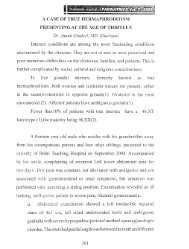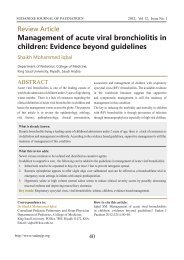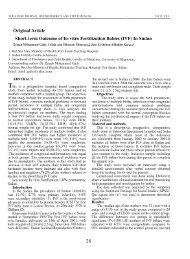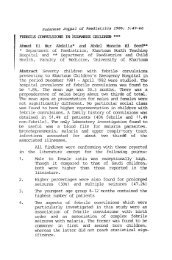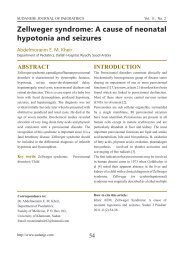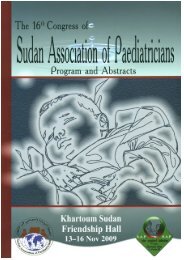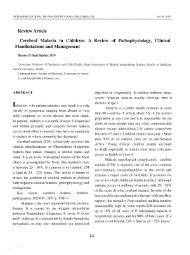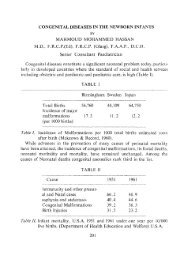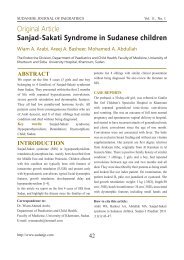conference programme and abstracts book - Sudanjp.org
conference programme and abstracts book - Sudanjp.org
conference programme and abstracts book - Sudanjp.org
Create successful ePaper yourself
Turn your PDF publications into a flip-book with our unique Google optimized e-Paper software.
Mothers' Perception, Knowledge <strong>and</strong> Practices regardingChildhood Malaria in SudanMubarak AI Rahman Mohamed, MBBS tu. of K.)Professor Zein Alabdin A. KarrarThis is a descriptive, cross-sectional, community-based study conducted between January-June2004. Five areas representing the endemicity categories in Sudan were selected.They were Khartoum (urban malaria), Sh<strong>and</strong>i (hypo endemic), Gedarif(seasonalmalaria), Kenana (irrigated malaria) <strong>and</strong> Wau (Perennial high transmission malaria).655 mothers of under 5 children were chosen through a multi stage r<strong>and</strong>om sampling;200 of them at health facilities accompanying their febrile children, who were examined& a BFFM was taken for them <strong>and</strong> 455 mothers at household level.330 (50.4%) of mothers, reported fever in last two weeks, 180(55.6%) of these weredue to malaria. However, the reported incidence of malaria during the survey time wasonly 11(5.5%).The perceived causes of fever were malaria in 396(62.8%), pneumonia 286(43.3%)& measles 92(14.6%). Convulsions as a risk of high fever was mentioned by 373(57.9%). Educated mother were significantly had better knowledge about fever causes<strong>and</strong> risk factors than illiterates.The causes of malaria as perceived by mothers include: mosquito 558(86.3%) exhaustion,dirt, bad food & blood transfusion. Fever <strong>and</strong> vomiting were the commonestsymptoms of malaria mentioned by 532(82%) & 380(58.6%) respectively; whilecough was the least 47(7.2%).More than 254 (40%) mothers think that severe malaria presents with convulsions,wnle only 25 (3.9%) mentioned jaundice <strong>and</strong>/or pallor. Education significantly affectskoowledge of danger signs, but ages of the mothers significant only in not able to drinkor breast -feed.595 (93.4%) mothers thought that BFFM was important, but 366 (56.4%) believed thatartipyretics given at home will affect the result.4E5(74.7%) of mothers sought help at a HF for childhood fever, 276(42.5%) gavehone-treatment <strong>and</strong> 52(8%) visited traditional healers. For malaria 608(93.7%) visiteda :-IF,26 (4%) gave home treatment <strong>and</strong> only 28(4.3%) went to traditional healers;hcwever, only 13(6.6%) visited HF within 24 hrs of fever.Fa convulsion, 355(55.8%) would visit HF & only 22(3.2%) mentioned traditionalhealers. Home-treatment of fever included cool bath in 327(57.8%), paracetamol in122(21.6%) <strong>and</strong> home remedies in 62( 11%). Traditional treatment of malaria includeduse of Aradaib (Tamarindus indica), Neem, Bee stings & others. Chloroquine was theco:nmonest antimalarial mentioned by 597(93.7%) <strong>and</strong> artemether was the least repcrtedby 54(8.5%). Correct chloroquine dose was given by 67(72%) & two thirds ofmothers preferred oral drugs.



